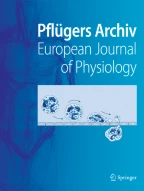Abstract
The activities of prolyl 4-hydroxylase and β-glucuronidase, the concentration of hydroxyproline as well as reticulin and collagen type III, IV and V stainings were followed in skeletal muscle during a 20-day period after a 9-h treadmill running in untrained and trained male mice, aged 4–6 months. The prolonged 9-h running of untrained mice temporarily increased prolyl 4-hydroxylase activity 2, 5 and 10 days after exercise, more prominently in the red than in the white part of quadriceps femoris-muscle, and in analogical manner as β-glucuronidase activity in tibialis anterior-muscle. Twenty days after exercise these enzymatic activities were back to the control level. The hydroxyproline content of red muscle was increased for 10 and that of white muscle for 20 days after the exertion. Training for 45 days did not affect hydroxyproline content and prolyl 4-hydroxylase activity was at the control level after the training. A 9-h exercise increased prolyl 4-hydroxylase activity much less in trained muscle than in the untrained muscle and did not affect muscle collagen content.
Histological observations showed fiber necrosis 2 days and signs of fiber regeneration 5 days after the exertion in untrained mice. Twenty days afterwards the regeneration was nearly completed. Reticulin staining was increased in injured muscle areas 10–20 days after the exertion. In immunohistochemical staining, antibodies to all studied collagen types (type III, IV and V) showed increased staining 5–20 days after the exertion in the areas of muscle injuries and regeneration. It is concluded that collagen metabolism is stimulated during the regeneration of muscle fibers and that preceeding endurance training is able to alleviate exrcise induced injuries.
Similar content being viewed by others

References
Baily AJ, Shellswell GB, Duance VC (1979) Identification and change of collagen types in differentiating myoblasts and developing chick muscle. Nature 278:67–69
Barret AJ (1972) Lysosomal enzymes. In: Dingle JT (ed) Lysosomes, a laboratory handbook. North-Holland, Amsterdam, pp 46–126
Duance VC, Stephens HR, Dunn M, Bailey AJ, Dubowitz V (1980) A role for collagen in the pathogenesis of muscular dystrophy. Nature 284:470–472
Foidart M, Foidart J-M, Engel WK (1981) Collagen localization in normal and fibrotic human skeletal muscle. Arch Neurol 38:152–157
Higman B, Altland PD (1963) Effects of exercise and training on serum enzyme and tissue changes in rats. Am J Physiol 205:162–166
Holloszy JO, Booth FW (1976) Biochemical adaptations to endurance exercise in muscle. Annu Rev Physiol 38:273–291
Juva K, Prockop DJ (1966) Modified procedure for the assay of3H- or14C-labeled hydroxyproline. Anal Biochem 15:77–83
Kivirikko KI, Myllylä R (1980) The hydroxylation of prolyl and lysyl residues. In: Freedman RB, Hawkins HC (eds) The enzymology of posttranslational modifications of proteins. Academic Press, London, pp 53–104
Kivirikko KI, Laitinen O, Prockop DJ (1967) Modifications of a specific assay for hydroxyproline in urine. Anal Biochem 19:249–255
Kovanen V, Suominen H, Heikkinen E (1980) Connective tissue of “fast” and “slow” skeletal muscle in rats — effects of endurance training. Acta Physiol Scand 108:173–180
Lowry DH, Rosebrough NJ, Farr AL, Randall RJ (1951) Protein measurement with the Folin phenol reagent. J Biol Chem 193:265–275
Myllylä R, Myllylä VV, Tolenen U, Kivirikko KI (1982) Changes in collagen metabolism in diseased muscle. I. Biochemical studies. Arch Neurol 39:752–755
Orrin RW, Gehron P, Mc Goodwin EB, Martin GR, Valentine T, Swarm R (1977) A murine tumor producing a matrix of basement membrane. J Exp Med 145:204–220
Peltonen L, Myllylä R, Tolonen U, Myllylä VV (1982) Changes in collagen metabolism in diseased muscle. II. Immunohistochemical studies. Arch Neurol 39:756–759
Risteli J, Tuderman L, Kivirikko KI (1976) Intracellular enzymes of collagen biosynthesis in rat liver as function of age and hepatic injury induced by dimethylnitrosamine. Biochem J 158:369–376
Rojkind M, Giambone M-A, Biempica L (1979) Collagen types in normal and cirrhotic liver. Gastroenterology 76:710–719
Sage H, Bornstein P (1979) Characterization of a novel collagen chain in human placenta and its relation to AB collagen. Biochemistry 18:3815–3822
Salminen A, Vihko V (1983) The susceptibility of mouse skeletal muscles to exercise injuries. Muscle Nerve 6:596–601
Salminen A, Hongisto K, Vihko V (1984) Lysosomal changes related to exercise injuries and training-induced protection in mouse skeletal muscle. Acta Physiol Scand 120:15–19
Schumann H-J (1972) Überlastungsnekrosen der Skelettmuskulatur nach experimentellem Laufzwang. Zentralbl Allg Pathol 116:181–190
Stephens HR, Duance WC, Dunn MJ, Bailey AJ, Dubowitz V (1982) Collagen types in neuromuscular diseases. J Neurol Sci 53:45–62
Suominen H, Heikkinen E, Parkatti T (1977) Effect of 8 weeks' physical training on muscle and connective tissue of m. vastus lateralis in 69-year-old men and women. J Geront 32:33–37
Takala TES, Myllylä R, Salminen A, Anttinen H, Vihko V (1983) Increased activities of prolyl 4-hydroxylase and galactosylhydroxylysyl glucosyltransferase, enzymes of collagen biosynthesis, in skeletal muscle of endurance trained mice. Pflügers Arch 399:271–274
Timpl R, Wick G, Gay S (1977) Antibodies to distinct types of collagens and protocollagens and their application to immunohistology. J Immunol Methods 18:165–182
Turto H, Lindy S, Halme J (1974), Protocollagen proline hydroxylase activity in work-induced hypertrophy of rat muscle. Am J Physiol 226:63–65
Vihko V, Rantamäki J, Salminen A (1978) Exhaustive physical exercise and acid hydrolyse activity in mouse skeletal muscle. A histochemical study. Histochemistry 57:237–249
Vihko V, Salminen A, Rantamäki J (1978) Acid hydrolase activity in red and white skeletal muscle of mice during a two-week period following exhaustive exercise. Pflügers Arch 378:99–106
Vihko V, Salminen A, Rantamäki J (1978) Exhaustive exercise, endurance training, and acid hydrolase activity in skeletal muscle. J Appl Physiol 47:43–50
Author information
Authors and Affiliations
Rights and permissions
About this article
Cite this article
Myllylä, R., Salminen, A., Peltonen, L. et al. Collagen metabolism of mouse skeletal muscle during the repair of exercise injuries. Pflugers Arch. 407, 64–70 (1986). https://doi.org/10.1007/BF00580722
Received:
Accepted:
Issue Date:
DOI: https://doi.org/10.1007/BF00580722


